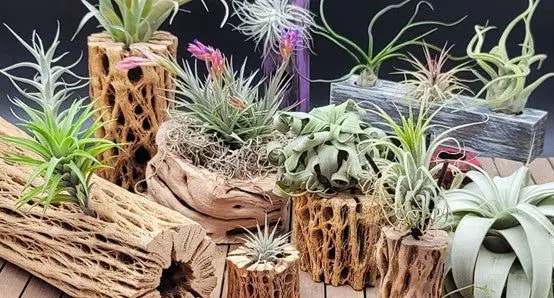Willy Green
April 11, 2023




How to care for air plants

Air plants, also known as Tillandsias, are unique and fascinating plants that have become increasingly popular in recent years due to their ability to thrive without soil. These plants absorb moisture and nutrients through their leaves, making them low-maintenance and perfect for those who want to add some greenery to their space without the hassle of traditional potted plants. However, despite their easy-going nature, air plants still require proper care to thrive. Today we will discuss the best ways to care for air plants.
Watering
The first and most important aspect of caring for air plants is ensuring they receive adequate water. Unlike traditional plants, air plants do not have roots to absorb moisture from the soil. Instead, they rely on absorbing water through their leaves. To water your air plants, simply mist them with a spray bottle two to three times per week, or soak them in a bowl of water for 30 minutes every two weeks. It is important to use filtered or distilled water, as tap water can contain harmful chemicals that can harm the plant. Additionally, air plants should be dried completely after watering to prevent rot and mold.
Fertilizing
In addition to water, air plants also require nutrients to thrive. While they can absorb some nutrients from the air, it is recommended to fertilize them every two to three weeks with a low-nitrogen liquid fertilizer. Simply dilute the fertilizer in water and mist the plant, or soak it in the solution for a few minutes. Be careful not to over-fertilize, as this can cause the plant to burn and die.
Lighting
Another important aspect of caring for air plants is providing them with proper lighting. While they do not require direct sunlight, air plants do need bright, indirect light to thrive. Place them near a window with filtered light, or under artificial light if necessary. Avoid placing them in direct sunlight, as this can cause the plant to dry out and become damaged.
Environment
Finally, air plants should be kept in a suitable environment. They prefer temperatures between 50-90°F, and humidity levels between 40-60%. If you live in a dry climate, consider placing a humidifier near your air plants or misting them more frequently. Air plants also benefit from good air circulation, so ensure they are not placed in a stagnant area. As their name suggests, air plants need good air circulation to thrive. They should be placed in an area with good air flow, such as near a fan or open window. This will help prevent the leaves from becoming too moist and developing rot.
It is also important to note that air plants can be susceptible to pests, such as mealybugs and spider mites. Regularly inspect your plants for any signs of infestation, such as white cottony spots or tiny webs. If you notice any pests, isolate the affected plant and treat it with a natural insecticide, such as neem oil or a mixture of water and mild soap. It is also a good idea to quarantine any new air plants before introducing them to your collection to prevent the spread of pests or diseases.
When it comes to displaying your air plants, the possibilities are endless. These plants can be mounted on a variety of surfaces, such as driftwood, rocks, or seashells, or placed in decorative holders or terrariums. Just be sure to choose a container that allows for proper air circulation and drainage, and avoid using soil or any other material that could hold moisture and cause the plant to rot.
In conclusion, caring for air plants is simple but requires attention to a few key factors. By providing them with water, nutrients, proper lighting, and a suitable environment, you can enjoy the beauty of these unique and fascinating plants in your home or office. Remember to regularly inspect them for pests and be creative with how you display them. Pay attention, water, and fertilize them regularly, provide them with proper lighting, and keep them in a suitable environment. With a little bit of care and creativity, air plants can thrive and bring a touch of nature to your home, office, or just about any space. Thank you for reading about how to care for air plants. Here are some other articles you may enjoy reading.







